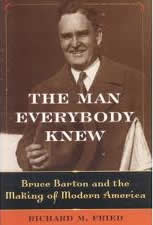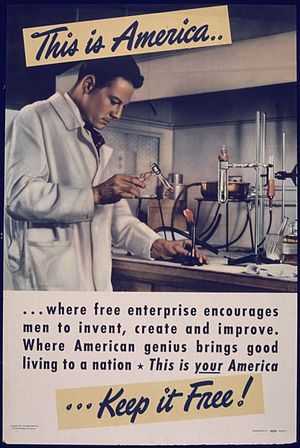From the beginning business had been encouraged in its free enterprise campaign by advertisers and public relations specialists who hoped for business opportunities from such a campaign. The American Federation of Advertising argued  in the 1930s that the obligation ‘to interpret what industry has done for the well-being of America’ was more important than promoting company products. PR consultant Bruce Barton (pictured) argued at the 1935 NAM convention that any manufacturer who declared his distain for popular opinion was ‘a liability to all industry. No major industry has the moral right to allow itself to be unexplained, misunderstood or publicly distrusted; for by its unpopularity it poisons the pond in which we all must fish.’ He argued that business needed to be ‘as diligent, as ingenious, and as resourceful’ in their approach to ‘the public as voters, as we have proved ourselves to be in our approach to them as buyers.’
in the 1930s that the obligation ‘to interpret what industry has done for the well-being of America’ was more important than promoting company products. PR consultant Bruce Barton (pictured) argued at the 1935 NAM convention that any manufacturer who declared his distain for popular opinion was ‘a liability to all industry. No major industry has the moral right to allow itself to be unexplained, misunderstood or publicly distrusted; for by its unpopularity it poisons the pond in which we all must fish.’ He argued that business needed to be ‘as diligent, as ingenious, and as resourceful’ in their approach to ‘the public as voters, as we have proved ourselves to be in our approach to them as buyers.’
Paul Garrett, Director of Public Relations at General Motors, told the American Association of Advertising Agencies:
The challenge that faces us is to shake off our lethargy and through public relations make the American plan of industry stick. For, unless the contributions of the system are explained to consumers in terms of their own interest, the system itself will not stand against the storm of fallacies that rides the air in this era of easy, world-wide and instantaneous communication.
For Garrett the ‘fallacy of fallacies’ was the belief that big companies were bad companies: ‘as if size had anything to do with morality ’. This arose because people ignored ‘the fact that the consumer and nobody else determines that industry sometimes must be small and sometimes must be big to serve him well’ and the fact that big businesses give rise to small businesses.
’. This arose because people ignored ‘the fact that the consumer and nobody else determines that industry sometimes must be small and sometimes must be big to serve him well’ and the fact that big businesses give rise to small businesses.
During the 1930s the advertising firm J. Walter Thompson demonstrated its skills at helping business educate the public about capitalism with an advertisement comparing state capitalism, where ‘the Politician is the boss’ with private capitalism where ‘the Consumer, the Citizen is boss’. It argued that under the system of private capitalism ‘The consumer is the voter, the juror, the judge and the executioner... The consumer ‘votes’ each time he buys one article and rejects another...’ The fact that it was not the ‘votes’ in the market place but rather the ‘votes’ in the political sphere that were of concern to corporations was deliberately obscured. Similarly advertising firm N. W. Ayer & Son produced twelve pamphlets explaining questions such as ‘Why Business Is Big’ to the public in an effort to get more advertising business from corporations.
Radio networks, trade journals and magazines also offered to help business influence public attitudes. The National Broadcasting Company (NBC) advertised to business leaders in 1937: ‘Faced with new situations, new standards of economics, new attitudes of labor, business must campaign for public favor as never before. It must recognize public good-will as the greatest possible force in Business, as it is in Government.... Use NBC to interpret your aims and ideals...’
New firms emerged that polled and surveyed public opinion on behalf of business on a range of political issues of concern to them and gave them feedback about how well their propaganda was working. The Psychological Corporation began the ‘Business Barometer’, a series of surveys of attitudes to big business carried out twice a year and attracting clients such as General Motors, DuPont, Ford, General Electric, US Steel, Westinghouse, AT&T, Standard Oil and others. The Opinion Research Corporation, Fortune magazine, and others, also conducted surveys of public opinion about big business. This ‘continuous feedback’ about the effectiveness of public relations campaigns enabled business to develop ‘a new sophistication’ in its propaganda techniques.
For some people this polling offered a new scientific form of democracy whereby public opinion could be measured. Historian Stuart Ewen notes: ‘Pollsters would henceforth be the messengers through whom the public interest would be ostensibly articulated. Abstract, statistical renditions of democracy and of the public itself were appearing; ideals or memories of a participatory public were being annulled.’
Of course the results of polling could be easily influenced by the choice of questions and the way they were phrased so that in reality polls were frequently purchased by those who wanted to show public opinion was on their side. ‘Reported in newspapers or cited on the radio, public opinion polls were becoming statistical applause tracks for encouraging those on the fence to join the crowd.’ They were part of the public manipulation, a part that was all the more insidious because it purported to show the public was in charge.
Advertisers utilised pollsters in their work. Paul West, president of the Association of National Advertisers explained why advertisers were the appropriate people for the job of selling free enterprise:
The advertising method, if properly utilized, can get our story across because, unlike any other method of communication, it starts by finding out through research what people want and what appeals they respond to, what they are confused about and where they are misinformed, it dramatizes and simplifies the message in terms of the other fellow’s interests; it channels the messages to the desired audience in predetermined units of space or time at desired intervals; and it repeats and repeats until the message sinks in, until ideas are moved from one mind to another.